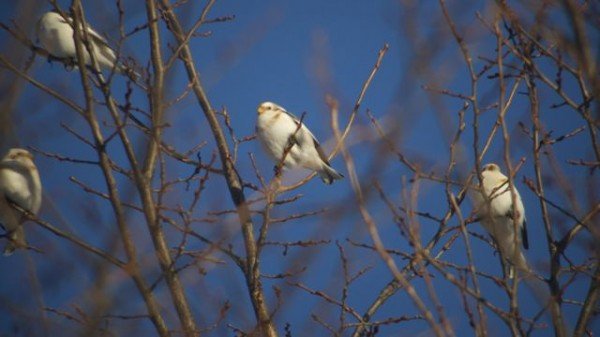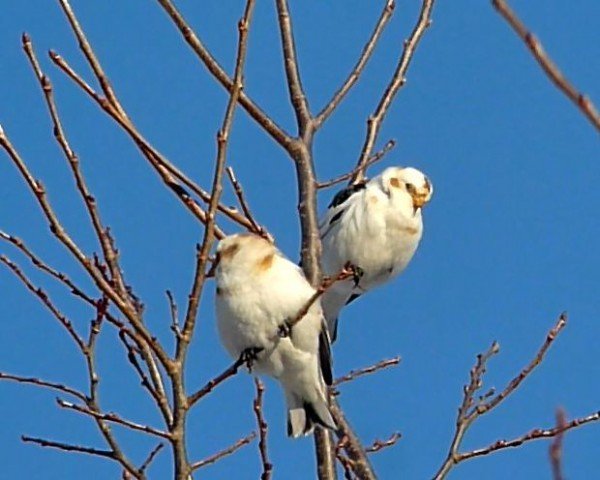Sometimes we watchers see birds do things that surprise us—things birds are not supposed to do. This happened to me recently on a birding trip, with somewhat egg-on-the-face results.
I was on a birding quest trip with my friend Geoff Heeter. We were driving up to northwestern Michigan from our homes in Ohio (me) and West ByGod Virginia (Geoff) in search of a bird species that would be a lifer for both of us: the Bohemian Waxwing. Now I’m not going to get into great detail here about the BOWA-related aspects of the journey. That’s a story for another time. What I will share is a story about Snow Buntings.
After departing our luxurious base camp in Bowling Green, Ohio (courtesy my gracious friend and hostess Anne), Geoff and I hit the open road in his Toyota truck, nicknamed (by me) The Back Breaker. Just a few miles up the interstate, and still within the snowy, friendly confines of northwest Ohio, I spotted a lone snow bunting flying across a half-mud, half-snow field. I called the sighting out and saw Geoff contort his neck wildly, trying to see it.
“Missed it!” he said
“But you saw the flash of black and white, right?” I asked.
“Kinda.” he replied tentatively. “The real question is: Did YOU see if well enough for ME to count it?” he added.
We laughed about that and I assured him that we’d probably see another one, or, more likely, a whole flock. We both knew it would be a life bird for him, but to speak openly of such things is to doom yourself to waiting years—if not decades–to see one.
Flash forward ten hours. Geoff and I are driving The Back Breaker slowly along ice-encrusted roads in the country outside Harbor Springs, Michigan (which, by the way, is the home of the most evasive Bohemian Waxwings on the planet). The first sunshine of the trip is glinting off the snow, casting a honey-yellow glow across the land, making it seem a lot warmer than it actually was. Geoff looks out the open truck window, glances upwards, and shouts: “I think a huge flock of snow buntings just flew over the road!”
“Black and white?” I ask, slamming on the brakes with no discernible result.
“Definitely!” he concurs.
We jump out of the still-skidding truck, struggle to regain our balance on the skating-rink quality icy road surface, and see the flock disappear, flying high to the west, over the adjoining woods.
“I think they may have landed in those trees in the back” Geoff offered.
“I doubt it. Snow Buntings are ground-loving birds, Heets. They NEVER land in trees.” I opined confidently.
We watched the empty sky for a few minutes, then realized the birds were gone for good. Back in the truck, working on our back spasms, we drove a hundred yards south, then turned east, passing a farm house which had feeders out front, and where a flock of Bohemian Waxwings had been reported that same morning. We found nothing remotely waxwinglike at the feeders, but we did notice two flocks of small birds that flew across the field behind the house, and over the windbreak into an adjoining field. At this great distance they were just small, dark silhouettes. We put ourselves and our backs back into The Back Breaker and drove/slid a quarter-mile down the ice to the next field.
This was Snow Bunting heaven. A wide-open field in a wind-protected spot, recently visited by both mechanical and living manure-spreaders. If there’s one thing a Snow Bunting loves to do, it’s pick its food out of manure. This spot had two flocks of buntings—each numbering about 20 birds. I was just laying some groovy Snow Bunting facts on Geoff as I focused the spotting scope on the nearer flock. The birds were surprisingly hard to spot, but eventually the scope found them and I stepped back to offer Geoff his life look at a life bird.
“See, they really love feeding on the ground, picking through the field pies for seeds and things. Blah-blah-blah” I went on, dumping so much info into Geoff ears that they might actually have begun hurting more than his back.
Down the road, the farmer’s tractor roared to life and the near flock of buntings was startled into flight. They flew around in a circle, and the flew directly toward us, landing in the tree over our heads.
“What was that tidbit about trees and Snow Buntings?” Heeter needled.
I pretended to ignore the question, instead making busy getting the birds in the scope. We both got great looks and I got a few digiscoped images.
And then, the farmer, who had been moving hayrolls a half-mile down the road, couldn’t stand it anymore and drove up the lane to see what we were doing. He was a friendly-looking old fellow, probably about 80, in his coveralls, muck boots, and tractor hat.
“What’re you fellers doin?”
“We’re looking at the birds in your field. They’re Snow Buntings! A really cool bird!”
“What? Birds? You fellers don’t have enough to do!” he said, implicating us as slothmongers.
“Well, thanks for letting us look at your birds!”
“Them black-and-white birds out there? Know what we call ’em? Sh*t-pickers!”
We laughed at this together, then Mr. Farmer bade us well:
“I mean it, boys. You got too much time on your hands. Me, I got work to do. Good bye!”
And off he drove, having cleared the road of sh*t-pickers, as well as lazy bird watchers.
As we contorted ourselves to get back into The Back Breaker, I explained to Geoff how lucky we were to have seen the buntings perch in a tree—to be witnesses to such unusual behavior.
“I’ve never seen that before. Pretty cool!” I added.
Geoff laughed and asked: “So what do I put on my life list. Snow Bunting? Or Sh*t-picker?”
My authoritative answer?
“Both!”













Great post, Bill!
And I guess the split adds another bird to my life list? 🙂
Now I have to try to find Snow Buntings in trees just for the novelty of it.
I’ve heard blue herons called “shitpokes.” I wonder if it’s a case of world-wide linguistic convergence.
They may perch in trees, but they don’t look very comfortable to me.
That’s quite a recounting, of just one tiny part, of a great adventure. I cannot wait to hear the rest of the stories. As for the comfort of the snow buntings, the wind blowing so hard it was pushing “Back Breaker” across the icy road without us in it, that may be the reason for the “look”. They seem quite at home in the tree tops.
It would have surprised me too … always seen them on the ground or on roofs.
Hey. Funny that our brother Kris saw tons of those
Birds you were seeking I’n front of his house!
Sorry we didn’t meet you.
Kari
This post captures some of that ineffable magic of birding with you, Bill. Sh*t happens.
Funny stuff! Snow Buntings are one of my all-time favorite birds — and I’ve only seen ONE in my life (…but he made quite an impression on me!)
I’ve seen Snow Buntings several times, always on the ground except once. That flock was perched in trees, near the Soo in the UP of Michigan and it was colder than the far side of the moon, i.e. a couple of degrees below zero in mid afternoon! Perhaps they were warming frost bitten feet.